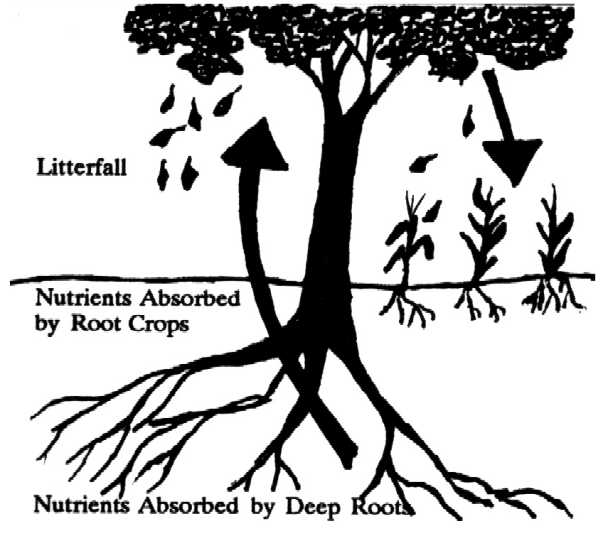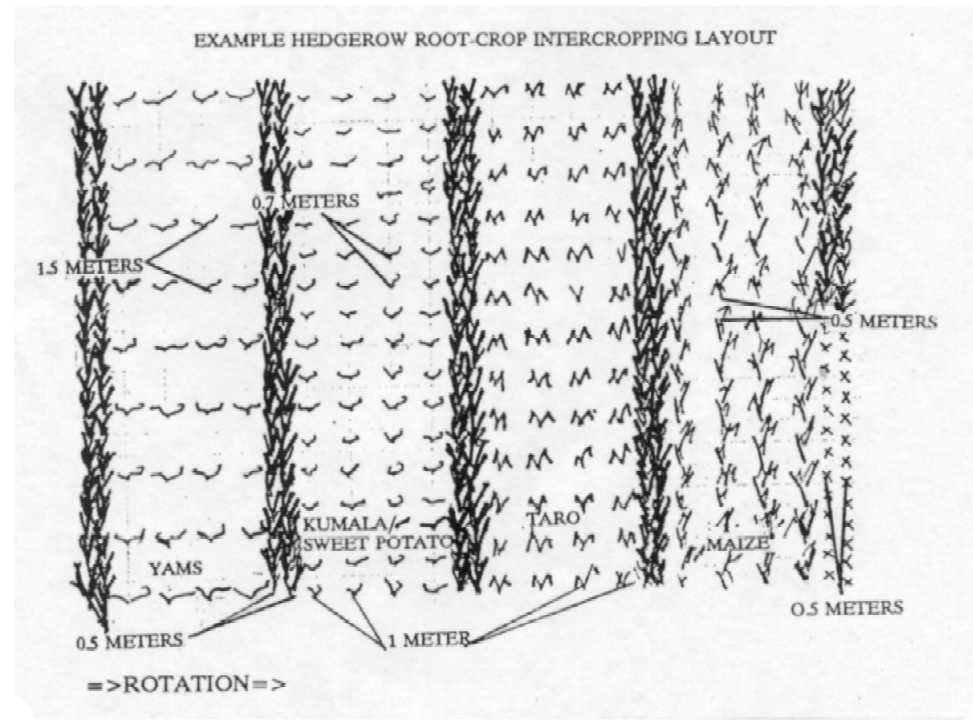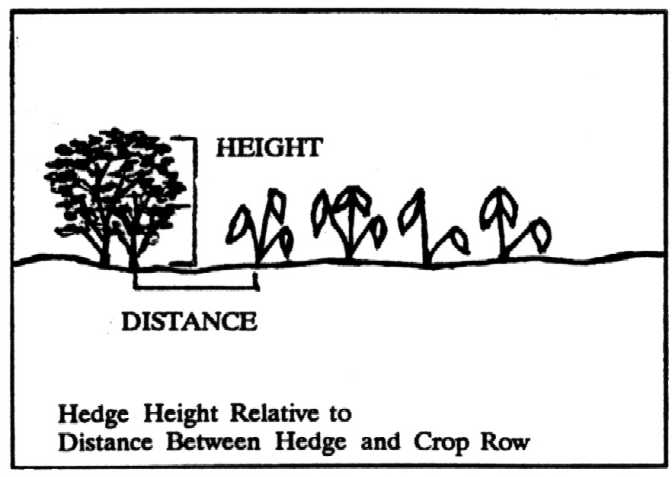
Hedgerow Intercropping with Upland Root Crops
Agroforestry for the Pacific Technologies
A publication of the Agroforestry Information Service
December 1992, Number 2
Root-crops, primarily taro, sweet potato, and cassava, are important subsistence and market foods in most Pacific Island cultures. Traditional upland root-crop cultivation included lengthy soil restoring fallows between short croppings. After just 2 to 3 years of root-crop production, lands were typically left to rest for 10 to 15 years. Farmers have always recognized that the planting and harvesting of root crops disturbs soils more than does the farming of above-ground crops. Root crops must be dug in and dug out.
Unfortunately, modern population pressures and land-ownership uncertainties are creating situations of land scarcity that make long fallows infeasible for most. The soil degradation resulting from shortened fallows is affecting productivity and increasing dependencies on food imports such as rice and flour in many areas.
 Hedgerow intercropping (HI), the practice of farming annual crops in the spaces or ‘alleys’ between rows of multipurpose trees is a promising alternative to the traditional fallow system. Trees planted and managed in hedgerows provide the same products and services as those that were allowed to grow during traditional fallow periods. Trees cycle nutrients from deeper in the soil profile by shedding organic matter on the surface as leafy and woody litter or ‘green manure’. Litter rebuilds a soil’s structure making it less erodible and more able to absorb and hold water. Hedgerows also yield other products such as fuelwood and fodder. They create a more favorable micro-climate for crops by shielding them from drying winds. Hedges planted on slopes, also anchor soil and form terraces, preventing the loss of precious topsoil by heavy rains and the overland flow of water.
Hedgerow intercropping (HI), the practice of farming annual crops in the spaces or ‘alleys’ between rows of multipurpose trees is a promising alternative to the traditional fallow system. Trees planted and managed in hedgerows provide the same products and services as those that were allowed to grow during traditional fallow periods. Trees cycle nutrients from deeper in the soil profile by shedding organic matter on the surface as leafy and woody litter or ‘green manure’. Litter rebuilds a soil’s structure making it less erodible and more able to absorb and hold water. Hedgerows also yield other products such as fuelwood and fodder. They create a more favorable micro-climate for crops by shielding them from drying winds. Hedges planted on slopes, also anchor soil and form terraces, preventing the loss of precious topsoil by heavy rains and the overland flow of water.
Traditional systems combined trees with crops on the same piece of land in a time sequence. Hedgerow intercropping; combines trees with annual crops on the same piece of land at the same time. The tree and crop components are managed so as to be complimentary rather than competitive. The succesful HI system maximizes the product per unit of land over time. To accomplish this, competition between the crops in the alleys and the trees in the rows must be minimized. This requires the orderly spatial arrangement and rather intensive management of the tree component. It could be said that traditional systems require a large land input whereas HI systems require more labor input. Where land is more scarce than labor, this agroforestry practice makes good sense.
Hedgerow intercropping; does not necessarily eliminate the fallow requirement. Because the tree component of the HI system is kept on the land during crop production, one could say that it performs a “semi-fallow” function continuously. This means that cropping cycles can be lengthened and fallows shortened without degrading the soil and reducing system productivity over time.
The trees recommended for these systems are chosen for their multipurpose/multiproduct characteristics. They provide soil-improving services, are fast-growing, and produce a number of useful products.
In short, the primary benefit of HI over traditional systems, is a more continuous, more sustainable flow of both tree and food products from one piece of land through time.
SETTING UP AND MANAGING A HEDGEROW INTERCROPPING SYSTEM
I. TREE SPECIES SELECTION
HI trees provide desired products/services while competing as little as possible with neighboring crops. Characteristics of good HI trees are:
- Rapid growth and biomass production: More leafy biomass and small branch production means more litter/mulch accumulation, more fodder, and/or more fuelwood.
- Smaller, bushy form: Smaller, multi-stemmed trees normally produce more biomass of a higher leaf: stem ratio than larger, single stemmed species.
- Deep-rooting: Take-up nutrients and water out of reach of root-crops.
- Easy to establish: Trees are easy to raise from seed either directly field-planted or in pots. Cuttings develop more rapidly but produce only lateral roots that compete more with neighboring crops
- Repeated coppicing and/or re-sprouting ability: Stems and leaves grow back again and again after pruning or topping.
- Nitrogen Fixing: Nitrogen fixing trees are able to ‘fix’ atmospheric nitrogen and contribute this to the system in leaf litter fall/break-down.
- Free from pests and diseases: Trees should not be hosts to crop-damaging insect or fungus pests.
- Easily controlled: Trees that become weedy and will spread into alleys or neighboring fields are not desireable.
- Widely adaptable and stress tolerant: Trees should be adapted to a range of soil characteristics and tolerant of nvironmental adversities such as high winds and periodic drought.
- Multipurpose: To provide an adequate return to land and labor inputs, trees must produce a number of useful products and services.
The multipurpose tree species so far identified as being very promising for Pacific Island use are: Calliandra calothyrsus, Gliricidia sepium, Flemingia macrophylla, and Erythrina subumbrans. All grow rapidly and produce. lots of soil enriching ‘green manure’, good fuelwood, and fodder. Calliandra and Gliricidia can both produce fuelwood diameter limbs within one year. Flemingia and Erythrina usually produce smaller diameter stems early-on, but more leaf litter than the other two. On very acid soils (
Albizia, Acacia, and Prosopis spp. all have a tendency to become weedy on islands. Leucaena species are also considered weeds in most situations and are attacked by psyllid insects when pruned repeatedly as in HI systems.
Paraserianthes falcataria and Cajanus cajan tend to die back after 3 or 4 years of repeated pruning. These species do not coppice very well in general. Parasetianthes is also very susceptible to wind damage.
HEDGEROW TREE SPECIES FOR PACIFIC ISLAND UPLANDS
Calliandra calothyrsus Gliricidia sepium
Flemingia macrophylla Erythrina subumbrans
Albizia saman Leucaena leucocephala
Pithecellobium dulce Leucaena diversifolia
Cajanus cajan Paraserianthes falcataria
Wise tree species selections cannot be made without considering planting site characteristics. Species all have unique sets of tolerances and preferences for certain soil types and climates. The following site factors must be examined so that, suitable tree species are selected:
- Mean annual precipitation.
- Mean annual temperature.
- Length and frequency of yearly droughts.
- Yearly/daily minimum and maximum temps.
- Incidence of frost.
- Topography: elevation, aspect, and %slope.
- Soil pH, texture, and depth.
II SPATIAL ARRANGEMENT
Orientation: The ideal tree row would be oriented east to west, perpendicular to prevailing winds, and parallel to slope contour. This orientation provides maximum ‘’alley’ (crop) sun exposure and maximum erosion control. Obviously, this is not always possible. Tree rows should be oriented to provide the most benefit and the least competition given the particular environment. Where there is slope, it is always best to plant along contours.
‘Alley’ Width: The most important HI system design decision is alley width. Alley width will determine the ratio of tree products/services to crop product and the degree of competition between the root-crops and trees. If alleys are too narrow, root-crop yields win drop off dramatically as tree hedges grow If alleys are too wide, the soil improving role of trees is reduced and long fallows will still be required. Based on tried systems, a 5 to 6 meter width is recommended.
Within row spacing: The recommended hedge consist of two lines of trees 50 cm. apart. Trees within the lines should be at 30 to 50 cm. spacings. Close spacings encourage more leaf and smaller branch production. In general HI systems of 2-row hedges and wider alleys are more productive than those of 1-row hedges and narrower alleys. With 2-row alleys, there is less tree-crop interface (competition).
Root-crop spacing: Root-crops should be planted at traditional spacings. The space between crop plants and any one tree row should be at least 0.5 m.

III. MANAGEMENT AND PRODUCT HARVESTS
 Hedge Pruning: Periodic hedge pruning is necessary to prevent trees from shading-out your crop. The amount/frequency of pruning required will depend on the shade tolerance of a particular root crop at a particular stage in development. Most root-crops are very light demanding but will benefit from some shade during the first couple months of development. Shade also discourages weeds. A good rule is to maintain a hedge height equal to the distance between the hedge and nearest crop row (50cm to 1m).
Hedge Pruning: Periodic hedge pruning is necessary to prevent trees from shading-out your crop. The amount/frequency of pruning required will depend on the shade tolerance of a particular root crop at a particular stage in development. Most root-crops are very light demanding but will benefit from some shade during the first couple months of development. Shade also discourages weeds. A good rule is to maintain a hedge height equal to the distance between the hedge and nearest crop row (50cm to 1m).
Pruning frequency will also depend on the product mix desired. More frequent pruning adds more ‘green manure’ to the soil. Less frequent pruning will produce more fuelwood-diameter branches.
The timing of prunings is more. important in tropical environments where leaf decomposition and organic matter mineralization occur rapidly. Prunings should be timed so that applied litter is releasing nutrients when the root crops are most demanding – during rapid corm development.
Crop Rotations and Fallows: Continuous cropping may be possible in some very productive HI systems where organic matter and nutrients are continually returned to the soil in large enough quantities.
It is likely though, that some fallow between the normal 3 to 4 year cropping period will be required. Two years seems to be a reasonable period. After a 2-year fallow, during which hedges are left alone, a major fuelwood harvest can be expected. Crop yields are the best indicator of the fallow requirement. Once the hedgerows are in place, the farmer should experiment with different fallow lengths to find the combination that yields the most while maintaining the site’s productivity. Different sites will require different management strategies. In any situation, continued, close observation of crop performance is essential.
PRODUCTS AND SERVICES PROVIDED BY TREE HEDGEROWS
- NUTRIENT CYCLING FROM DEEPER SOIL LAYERS
- GREEN MANURE AND MULCH BENEFIT COMPANION FOOD CROPS
- MULCH AND SHADE SUPPRESS WEEDS
- FAVORABLE CONDITIONS FOR BENEFICIAL SOIL ORGANISMS
- BARRIER TO CONTROL SOIL EROSION
- BARRIER TO DRYING WINDS
- PRUNINGS FOR ANIMAL FODDER
- PRUNINGS FOR FIREWOOD AND POLES
- SUPPLY BIOLOGICALLY FIXED NITROGEN TO SYSTEM
ACKNOWLEDGEMENT
The technical guidelines offered here are based largely on information collected by the AIS Information Officer during field visits and personal interviews with project personnel. The following research projects are especially noteworthy and continue to provide useful information on this subject for all those interested:
EC/Pacific Region Agricultural Program Agroforestry Trials at USP Alafua, Apia, Western Samoa. Stephen Rogers, IRETA Research Fellow.
Plantation Training Center, Integrated Smallholder Cropping/Livestock Trials, Montmartre, Port Vila, Vanuatu. Charles Rogers, Project Manager.
GTZ/Fiji-German Forestry Project, PO Box 14041, Suva, Fiji. Martin Homola, Chief Forestry Advisor, and Wieland Kunzel, Technical Advisor.
A publication of the Forest, Farm, and Community Tree Network (FACT Net)
Winrock International
Email: forestry@msmail.winrock.org
